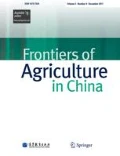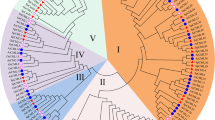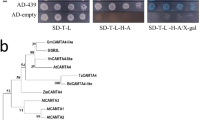Abstract
Multiple calmodulin (CaM) isoforms exist in plant organisms and vary by their primary structures of 148 amino acids. They have different expression patterns and/or target enzyme activation abilities. To further understand the biological significance of TaCaM isoforms, total RNA was isolated from mature leaves of wheat and then TaCaM2-3 gene was amplified by PCR after reverse transcription. The PCR product was generated into T-easy vector to subsequently sequence. Then the recombinant expression vector (pET28a-TaCaM2-3) was constructed and transformed into E. coli strain BL21 to obtain a high level expression vector of CaM. SDS-PAGE analysis showed that the recombinant E. coli could express an approximate 20 kD protein. A western blotting analysis showed an anti-CaM monoclonal antibody specifically bound to the 20 kD band of expressed product. TaCaM-II was purified by Ni-NTA affinity chromatography from recombinant bacterial lysate. TaCaM-II protein was used to immunize New Zealand white rabbits to produce a polyclonal antiserum. The specificity of the anti-TaCaM-II antiserum was successfully verified by western blotting analysis.
Similar content being viewed by others
References
Cao Z, Zhang J, Li Y, Xu X, Liu G, Bhattacharrya M K, Yang H (2007). Preparation of polyclonal antibody specific for AtPLC4, an Arabidopsis phosphatidylinositol-specific phospholipase C in rabbits. Protein Expr Purif, 52:306–312
Gawienowski M, Szymanski C D, Perera I Y, Zielinski R E (1993). Calmodulin isoforms in Arabidopsis encoded by multiple divergent mRNAs. Plant Mol Biol, 22:215–25
Guan C L (2006). The role of calcium on wheat hypersensitive reaction induced by wheat leaf rust fungus. Dissertation for the Master Degree. Baoding: Agricultural University of Hebei (in Chinese)
Heo W D, Lee S H, Kim M C, Kim J C, Chung W S, Chun H J, Lee K J, Park C Y, Park H C, Choi J Y, Cho M J (1999). Involvement of specific calmodulin isoforms in salicylic acid-independent activation of plant disease resistance responses. Proc Natl Acad Sci USA, 96: 766–771
Hou C Y, Wang Z X, Wang D M (2007). The effects of Ca2+ on the induction of defence responses by wheat leaf rusts. Acta Agriculturae Boreali-Sinica, 22(1):143–145 (in Chinese)
Huang C, Hou C Y, Wang D M (2008). Preparation and purification of rabbit anti-wheat calmodulin antiserum. Journal of Agricultural University of Hebei, 36(6):55–58 (in Chinese)
Huang C (2008). Preparation of rabbit anti-wheat calmodulin polyclonal antibody. Dissertation for the Master Degree. Baoding: Agricultural University of Hebei (in Chinese)
Liu G (2004). Study on the changes of cytosolic calcium dynamics during wheat-leaf rust fungus interaction. Dissertation for the Master Degree. Baoding: Agricultural University of Hebei (in Chinese)
McAinsh M R, Hetherington A M (1998). Encoding specificity in calcium signalling systems. Trends Plant Sci, 3:32–36
Mao A J, Wang Z X (1995). Calcium and Calmodulin participation in wheat-leaf rust interaction of the preliminary study. Journal of Hebei Medical College, 16(4):23–26 (in Chinese)
Rudd J J, Franklin T V E (2001). Unravelling response-specificity in Ca2+ signalling pathways in plant cells. New Phytol, 151:7–33
Snedden W, Fromm H (2001). Calmodulin as a versatile calcium signal transducer in plants. New Physiol, 151, 35–66
Takezawa D, Liu Z, An G (1995). Calmodulin gene family in potato: developmental and touch-induced expression of mRNA enconding a novel isoform. Plant Mol Biol, 27: 693–703
Wang J (1999). The molecular mechanism of plant disease resistance, Plant Physiology and Molecular Biology. Beijing: Science Press, 784–807 (in Chinese)
Wang Z X, Yang X P (1992). The varieties of physiological and biochemical in wheat leaf rust infection on various disease resistance wheat, Physiology of plant resistance. Jinan: Shandong Science and Technology Press (in Chinese)
Xiao B, Fan S, Zeng Z, Xiong W, Cao L, Yang Y, Li W (2006). Purification of novel UBAP1 protein and its decreased expression on nasopharyngeal carcinoma tissue microarray. Protein Expr Purif, 47:60–67
Yang T, Segal G, Abbo S, Feldman M, Fromm H (1996). Characterization of the calmodulin gene family in wheat: structure, chromosomal location, and evolutionary aspects. Mol Gen Genet, 252:684–694
Author information
Authors and Affiliations
Corresponding author
About this article
Cite this article
Liu, W., Yan, A., Hou, C. et al. Cloning and prokaryotic expression in TaCaM2-3 of wheat and preparation of antiserum. Front. Agric. China 4, 317–322 (2010). https://doi.org/10.1007/s11703-010-0015-0
Received:
Accepted:
Published:
Issue Date:
DOI: https://doi.org/10.1007/s11703-010-0015-0




